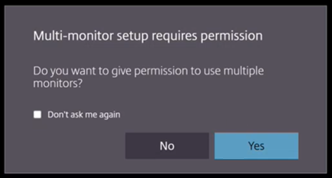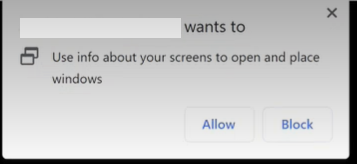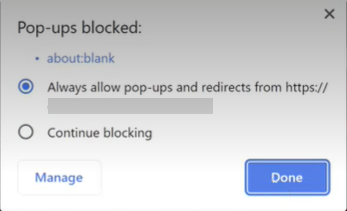Multi-monitor
Multi-monitor support
Previously, the multi-monitor display feature allowed you to open an extra browser tab of the desktop or app session that you were connected to. You were able to drag the additional browser tab to the external monitor.
Now, Citrix Workspace app supports multiple monitors with one click without manual intervention. If there are no external monitors attached to the device, the multi-monitor icon on the in-session toolbar is hidden. When you connect an external monitor with the required permissions, the multi-monitor icon is visible. After you click the icon, you can see the window span across all the connected monitors.
This feature is enabled by default.
Note:
- When your IT administrator disables the feature, you continue to see the old behavior. That is, you can see an extra browser tab of the desktop or the app session when you click the multi-monitor icon.
The multi-monitor feature supports the following:
- You can use up to two external monitors.
- You can use different display layouts of the multi-monitor.
- This feature is only supported on Google Chrome and Microsoft Edge Chromium browsers on Windows.
- The macOS devices support the older behavior. That is, when you click the Multimonitor icon on the toolbar, a secondary window of the desktop or application session appears to which you’re connected. You can then drag the secondary window to the secondary monitor.
-
You can use your virtual desktop in full-screen mode across a subset of available monitors. You can drag your virtual desktop to span to two monitors (out of more than two) and then select multi-monitor mode. A typical use case for this scenario is:
- when you run a video conferencing app on your native device monitor and want to view your virtual desktop contents in full-screen across your other two monitors during the call.
To use the feature
-
As a first-time user, when you start a session, the following pop-up appears seeking your permission to use the multi-monitor setup.

-
Click Yes.

The pop-up appears from the browser to seek permission to use multiple monitors. If you click Block, you can’t use multiple monitors.
-
Click Allow.

The pop-up appears to let you know about the pop-up blockers.
-
Click Okay. Navigate to the browser settings and select Always allow pop-ups.

-
Click Done.
Note:
Make sure to restart the session for the changes to take effect.
-
On your primary monitor, click the multi-monitor icon
 .
.You can see the window span across all the connected monitors.
Important:
If you deny multi-monitor permissions, the multi-monitor icon doesn’t appear. Instead, the full-screen icon appears in the toolbar, which takes you to the older behavior. To manually re-enable the multi-monitor permissions, go to the browser Settings > Privacy and security > Site Settings > Permissions > Additional permissions, and allow Window placement.
Notes
- On the external monitor, resource windows aren’t in full-screen mode. Instead, it is in windowed mode with a size equal to the external monitor size. We recommend manually switching to full-screen for a better user experience on each of the external monitor windows. To view in full-screen mode, on Windows device use F11 key. On your Mac, move the pointer to the green button in the top-left corner of the window, then choose Enter Full Screen from the menu.
- Multi-monitor state isn’t remembered across sessions on different devices. So, you must manually click the multi-monitor icon on the toolbar for every session.
Feature limitations
- In a multi-monitor setup, the session gets restored to the single monitor mode when:
- you use Microsoft Teams to share the screen on the primary monitor.
- you select the Logging or the Upload option in the toolbar. Click the multi-monitor icon to continue using multiple monitors.
- On a macOS devices, the secondary window opens as a new tab in Google Chrome browser.